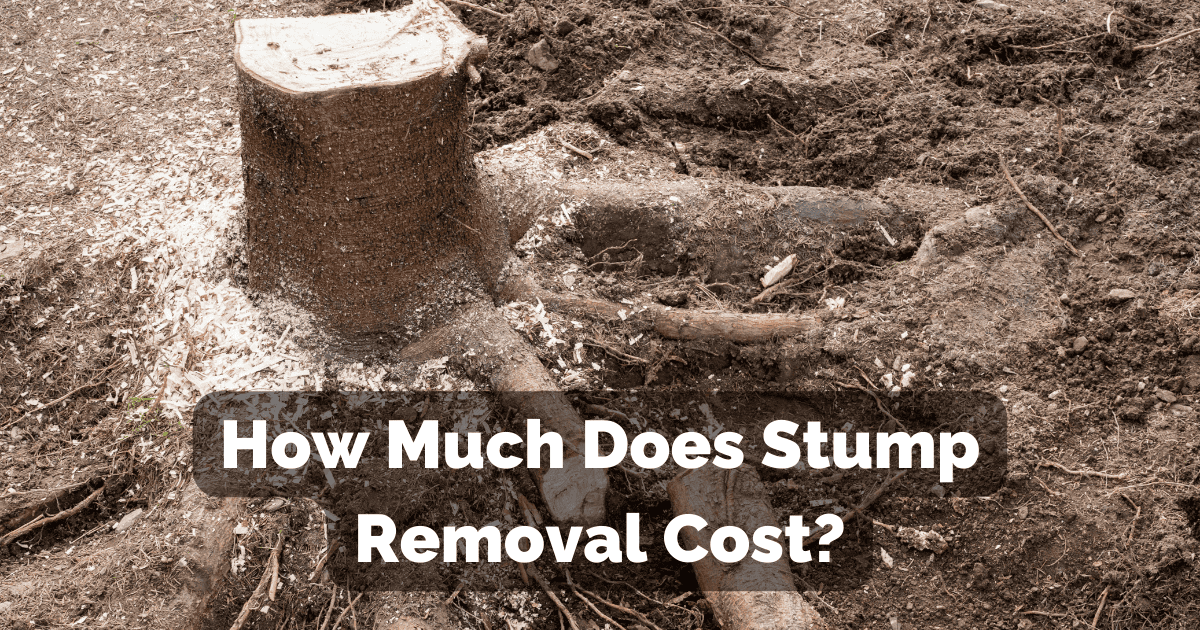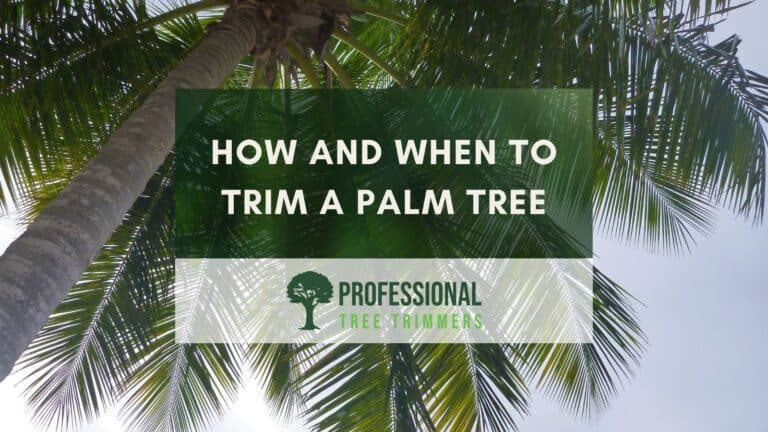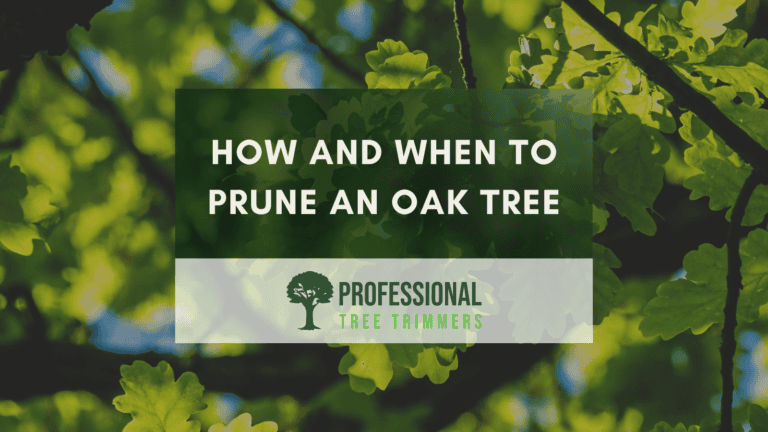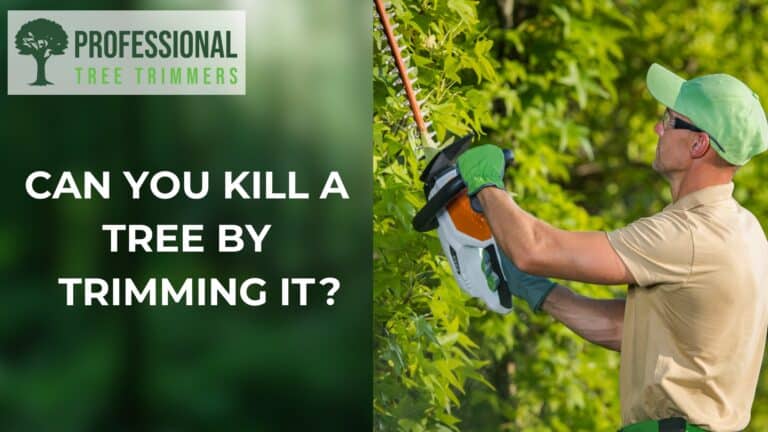Stump removal is essential for property maintenance and landscaping, as it eliminates the remains of cut or fallen trees. The process entails extracting the stump and roots from the ground. Aesthetic reasons primarily drive stump removal, as it enhances a property’s appearance and safety.
Moreover, it prevents pests and diseases linked to decaying wood, protecting nearby plants’ health.
Average Stump Removal Cost
Stump removal cost can range from $75 to $550, with various factors influencing the pricing, including stump size, removal method, location, root complexity, hourly rates, and additional services.
On average you can expect the stump removal to cost $360. Larger stumps often significantly increase the price, ranging from $2 to $5 per inch of the tree stump.
Often the selected method of stump removal will affect the cost as well, for example:
- Manual Removal: $200 – $700
- Stump Grinding: $150 – $500
- Chemical Rotting: $60 – $200
- Stump Burning: $100 – $200
It is crucial to consider these factors and potentially consult with local professionals for accurate estimates.
Factors Influencing the Cost of Tree Stump Removal
Removing tree stumps involves several factors that can influence the overall cost. Let’s dive into the key considerations:
- Know the Age of the Wood: Understanding the age of the wood is crucial, as older stumps may require more effort and resources for removal.
- Consider the Tree Type: Different tree types can impact the removal process. Hardwood or softwood stumps may have distinct characteristics affecting the cost.
- Measure the Stump Size: The size of the stump is a significant factor. Larger stumps generally require more time, labor, and equipment, contributing to increased costs.
- Assess Accessibility: The ease of access to the stump site plays a role. Accessibility challenges may require additional measures, affecting the overall removal cost.
- Consider Location and Distance: The location of the stump and the distance to transport debris can influence costs. Remote locations or challenging terrains may incur extra expenses.
- Identify the Root System: The complexity of the root system affects removal difficulty. More intricate root systems can contribute to increased costs.
- Check the Soil Type: Soil type matters as it can impact the ease of extraction. Different soil conditions may require specific equipment or methods, affecting costs.
- Determine a Suitable Removal Method: Various methods, such as grinding or using specialized equipment, can impact costs. Choosing the right removal method for the specific stump is essential.
How Does the Size of The Stump Affect the Cost of Stump Removal?
Stump size is identified as one of the most significant factors influencing the cost of removal. Larger stumps require more time, labor, and resources, contributing to the overall increase in removal costs.
To accurately calculate costs, measure the stump diameter at ground level, considering factors like wood age and tree type. Multiple stumps or challenging locations may lead to varied pricing.
On average stump removal can cost $2 to $5 per inch per stump.
| Stump Diameter (inches) | Approximate Cost for Stump Removal |
| 10 | $20 – $50 |
| 20 | $40 – $100 |
| 30 | $60 – $150 |
| 40 | $80 – $200 |
| 50 | $100 – $250 |
| 60 | $120 – $300 |
| 70 | $140 – $350 |
| 80 | $160 – $400 |
What Role Does the Type of Tree Play in Determining Stump Removal Cost?
The type of tree plays a crucial role in determining the cost of stump removal. Hardwood trees like maple and oak, being harder to remove, contribute to increased removal costs.
Overall, the size and type of the tree are essential factors to consider when estimating stump removal costs.
These factors, alongside the specific circumstances and additional services required, contribute to the final price quoted by tree care professionals and companies. It’s advisable to consult with professionals to get accurate estimates tailored to the unique characteristics of the tree in question.
Is Professional Stump Removal Cost-Effective?
Professional stump removal can be cost-effective depending on the size and number of stumps that need to be removed. Homeowners often do not have the experience of operating a stump grinder, and can not ensure their safety or be efficient while removing the stump. Thus in most cases, professional stump removal is cost-effective.
Diy Cost to Remove a Stump Yourself
The DIY cost to remove a stump yourself is approximately $75 to $150. If opting for DIY, rental stump grinders start at around $150 a day, but larger equipment may cost more. Chemical options like potassium nitrate for burning are a cheaper alternative, usually less than $10.
However, you might need to buy items like safety glasses, work gloves, hearing protection, a shovel etc. All these might cost you around $120 to $400 easily. But you can use the same tools again in your future DIY projects as well.
While DIY is cheaper, it’s labor-intensive, and rental grinders may be effective only on small stumps.
Can I Remove a Stump Myself?
Yes, you can remove a stump yourself using various methods such as digging, grinding, or burning. However, it’s important to note that removing a stump is a labor-intensive task that requires time, effort, and the right tools. If you prefer not to do it yourself, you can hire a professional to remove the stump for you.
How Long Does It Take for A Tree Stump to Rot with Epsom Salt?
It takes approximately six to twelve months for a tree stump to rot using Epsom salt. This involves drilling multiple holes into the stump, with the number of holes dependent on the stump’s size. For optimal results, deeper holes are recommended. Epsom salt is known for efficiently drying out the roots and the remaining trunk, making it a reliable option for stump removal.
The decomposition process is significantly accelerated with Epsom salt, shortening the time frame to 6–12 months compared to three to seven years without its use. Using a tarpaulin to cover the stump and its surroundings, while applying Epsom salt treatment weekly, is a practical approach.
Larger stumps may take a bit longer, around a month or two, and it’s advisable to reapply Epsom salt every three weeks for consistent effectiveness.
The salt works by cutting off the moisture supply to the roots, leading to stump death within approximately a month. When determining the effectiveness, pay attention to the stump’s wood – brittle and dark wood indicates the stump is dead, while soft and light wood suggests the stump is still alive.
Comparing the Cost of Grinding versus Manual Removal
Comparing the cost of stump grinding versus manual stump removal involves considering various factors. Stump grinding is generally more cost-effective whereas manual stump removal tends to cost more, as it requires more labor and equipment.
| Stump Removal Method | Average Cost |
| Manual Removal | $200 – $700 |
| Stump Grinding | $150 – $500 |
Grind a Stump or Remove it?
When deciding between grinding and removing a stump, consider the following factors:
- Efficiency: Grinding is generally faster and more efficient than removal, as it leaves some of the stumps behind.
- Cost: Grinding is typically less expensive than removal, making it a budget-friendly choice for homeowners.
- Roots and Damage: Grinding leaves the tree’s roots behind, which can be beneficial for preserving the surrounding landscape. However, it may not be suitable for areas with underground utilities or structures.
- Mulch Benefits and Aesthetics: Grinding provides natural mulch that can be used in other areas of your yard, offering additional benefits beyond stump removal. It’s often preferred for its aesthetic appeal, making it a suitable choice for homeowners concerned with the visual impact of stump remnants.
- DIY Risks and Safety: Grinding is less damaging and safer than removal, making it a suitable option for DIY enthusiasts. However, it’s essential to follow safety guidelines and consider the risks involved before attempting to grind a stump yourself.
- Planting and Land Use: Grinding is suggested for aesthetics or replanting purposes. It’s not always necessary, but neglecting to grind stumps may result in suckers growing for a few years.
Ultimately, the choice between grinding and removal depends on your specific situation and preferences. Grinding is generally more efficient, cost-effective, and environmentally friendly, while removal provides a cleaner slate but may be more expensive and damaging. Consider these factors and weigh the pros and cons before making a decision.
Tips to Reduce Cost While Removing a Tree Stump
When it comes to removing a tree stump, there are several tips and tricks to help you save money:
- Understand stump removal costs as cutting down a tree and removing a stump are separate tasks.
- Explore DIY stump removal methods like drilling deep holes and pouring Epsom salt or using stump killers.
- Seek competitive quotes from multiple services and negotiate for better prices.
- Prepare the site by clearing bushes before calling experts.
- Explore chemical stump removal by drilling holes into the stump.
- If you have multiple stumps that need to be removed, consider having them removed at the same time. This can save you money on labor costs.
What Is Stump Removal and Why Is It Necessary?
Stump removal is the process of eliminating a tree stump from the yard, leaving behind a void that requires filling. This task can be accomplished manually or with the assistance of specialized equipment, depending on the size and type of the stump.
Stump removal is necessary for the following reasons:
- Aesthetics: Decaying stumps can lower property value
- Safety: Stumps can damage lawnmowers or other equipment
- Planting new trees: Stumps and roots can hinder new tree planting
- Pests: Stums can attract termites and carpenter ants.
- Suckering and fungal root rots: Stumps can cause problems with suckering and fungal root rots in nearby plants
However, In some cases, stump grinding can be a more practical option, as it involves grinding the stump down into small wood chips, which kills the roots and prevents further growth.
Conclusion
In conclusion, while DIY stump removal can save money, it may come with hidden costs, safety risks, and labor intensity. Professional arborist services, although pricier, guarantee safety, quality, and efficiency. Stump size and tree type impact costs, and professional services offer convenience and expertise.
Epsom salt is a slower alternative, while grinding is more cost-effective and beneficial than manual removal. Cost-reduction strategies include negotiations, debris management, and comparing quotes.
Ultimately, the choice between professional and DIY methods depends on individual preferences, resources, and desired outcomes. If you need any professional help with stump removal you can always talk to one of our experts at 561-502-8733.




